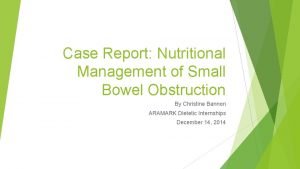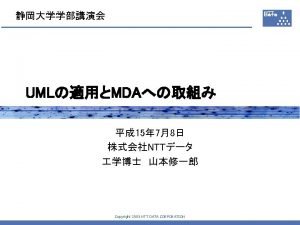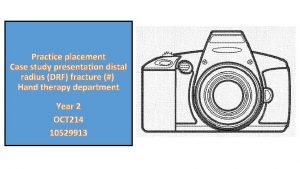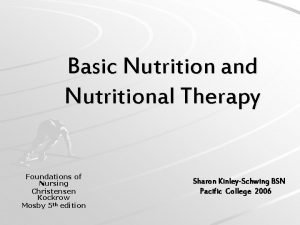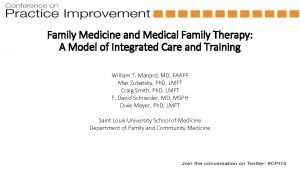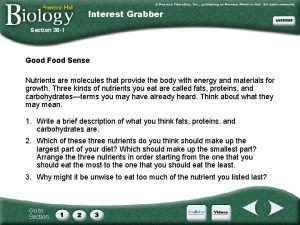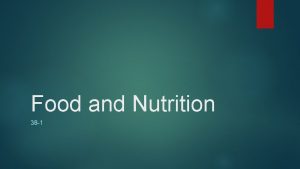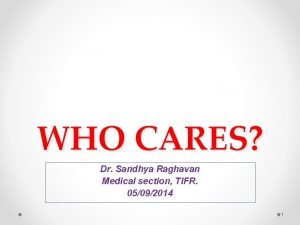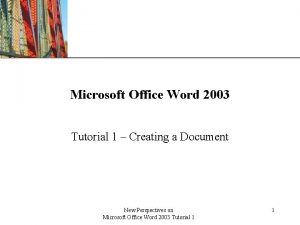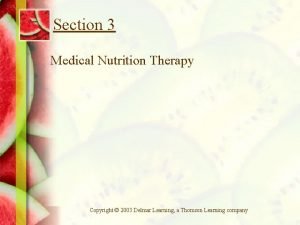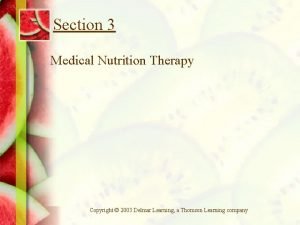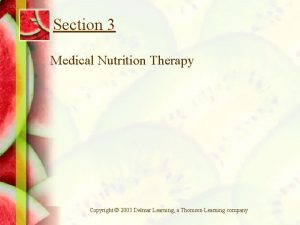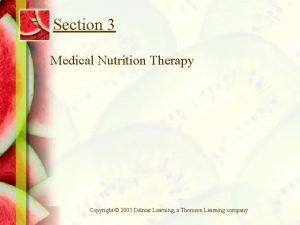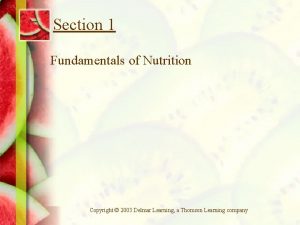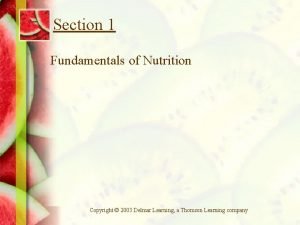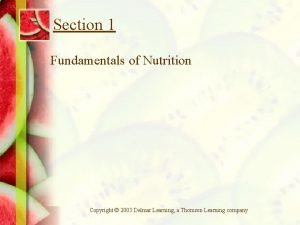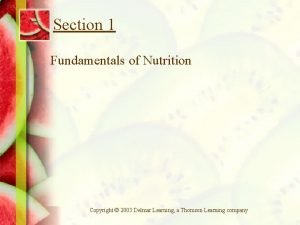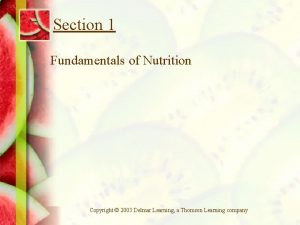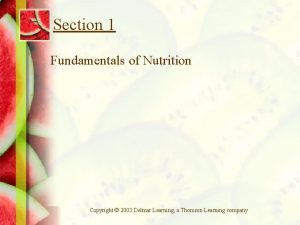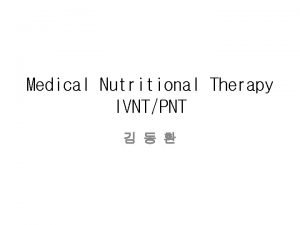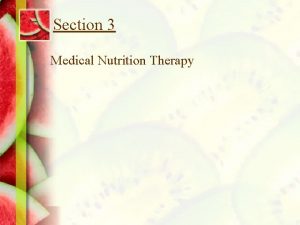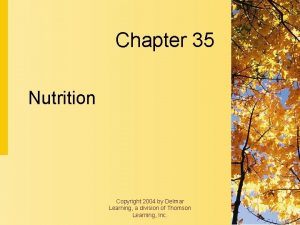Section 3 Medical Nutrition Therapy Copyright 2003 Delmar










































- Slides: 42

Section 3 Medical Nutrition Therapy Copyright © 2003 Delmar Learning, a Thomson Learning company

Chapter 16 Diet and Weight Control Copyright © 2003 Delmar Learning, a Thomson Learning company

Objectives § § § Chapter 16 Discuss the causes and dangers of overweight Discuss the causes and dangers of underweight Identify foods suitable for high-kcal diets and those suitable for low-kcal diets Copyright © 2003 Delmar Learning, a Thomson Learning company 3

“Rule of Thumb” Method for determining desired weight. Males assume 106 pounds for the first 5 feet (60 inches) and add 6 pounds for each inch over 60. Females assume 100 pounds for the first 5 feet (60 inches) and add 5 pounds for each inch over 60. Chapter 16 Copyright © 2003 Delmar Learning, a Thomson Learning company 4

“Rule of Thumb” Large-boned individuals of both sexes increase the first sum by 10%. Small-boned individuals of both sexes decrease the first sum by 10%. Chapter 16 Copyright © 2003 Delmar Learning, a Thomson Learning company 5

Definitions Overweight: Obesity: Underweight: Chapter 16 10 to 20% above average 10 to 15% below average Copyright © 2003 Delmar Learning, a Thomson Learning company 6

BMI Body Mass Index Medical standard used to define obesity. Used to determine whether a person is at health risk from excess weight. Obtained by dividing weight in kilograms by height in meters squared. Chapter 16 Copyright © 2003 Delmar Learning, a Thomson Learning company 7

BMI Fewer health risks are associated with a BMI range of 19 to 25 than with a BMI above or below that range. A BMI greater than 25 indicates obesity and health risks. Chapter 16 Copyright © 2003 Delmar Learning, a Thomson Learning company 8

Fat Distribution Fat in the abdominal cavity is associated with a greater risk for hypertension, diabetes, coronary heart disease, type 2 diabetes, and certain types of cancer than fat in the thigh, buttocks, and hip area. Pear-shaped body has a lower risk for disease than does apple-shaped body. Chapter 16 Copyright © 2003 Delmar Learning, a Thomson Learning company 9

Overweight and Obesity Overweight is a serious health hazard. It increases susceptibility to diabetes mellitus and hypertension. No one cause for obesity. Energy imbalance is a significant cause. Chapter 16 Copyright © 2003 Delmar Learning, a Thomson Learning company 10

Theories of Weight Loss Fat cell theory: obesity develops when the size of fat cells increase. Set point theory: everyone has a set point or natural weight at which the body is so comfortable that it does not allow for deviation. Chapter 16 Copyright © 2003 Delmar Learning, a Thomson Learning company 11

Healthy Weight Not everyone can match the “healthy weight target”, which is a BMI of 19 to 25. A “healthy weight” may be the weight at which one is eating nutritiously, is exercising, has no health problems, and is free from disease. Chapter 16 Copyright © 2003 Delmar Learning, a Thomson Learning company 12

Dietary Treatment for Obesity Reduce one’s food intake Weight-reduction (low-kcal) diet Base on the Food Guide Pyramid Use exchange lists to control kcal value Counting fat grams is another method Chapter 16 Copyright © 2003 Delmar Learning, a Thomson Learning company 13

Dietary Treatment for Obesity Reduction of 3, 500 kcal results in weight loss of one pound. No more than 1 to 2 pounds lost in a week. Do not reduce below 1, 200 kcal per day. Diet should consist of 15 to 20% protein, 45 to 55% carbohydrate, 30% or less fat. Key is changing eating habits. Chapter 16 Copyright © 2003 Delmar Learning, a Thomson Learning company 14

Food Selection Substitution foods: • • Chapter 16 Fat-free milk for evaporated milk Evaporated fat-free milk for evaporated milk Yogurt or low-fat sour cream for regular sour cream Lemon juice and herbs for heavy salad dressings Copyright © 2003 Delmar Learning, a Thomson Learning company 15

Food Selection Substitution foods: • • Chapter 16 Fat-free salad dressings for regular salad dressings Fruit for rich appetizers or desserts Bouillon instead of cream soups Water-packed canned foods rather than those packed in oil or syrup Copyright © 2003 Delmar Learning, a Thomson Learning company 16

Low-kcal Foods Black coffee Plain tea Cantaloupe Strawberries Lettuce Bean sprouts Cabbage Mushrooms Chapter 16 Asparagus Tomatoes Zucchini Cauliflower Broccoli Celery Cucumbers Spinach Red/green peppers Copyright © 2003 Delmar Learning, a Thomson Learning company 17

Cooking Methods Broiling, grilling, baking, roasting, poaching, boiling Trim fat from meat before cooking Skim fat from the tops of soups and meat dishes Avoid addition of extra butter or margarine Chapter 16 Copyright © 2003 Delmar Learning, a Thomson Learning company 18

Exercise Excellent adjunct to any weight-loss program Lowers set point Dancing, jogging, bicycling, skiing, rowing, power walking Such exercise helps tone muscles, burns kcal, increases the BMR so food is burned faster, and is fun for the participant. Chapter 16 Copyright © 2003 Delmar Learning, a Thomson Learning company 19

Stop and Share Your client would like to use behavior modification for weight loss. What recommendations could you give your client? Chapter 16 Copyright © 2003 Delmar Learning, a Thomson Learning company 20

Stop and Share Weigh regularly, but not daily. Don’t wait too long between meals. Join a support group and go to meetings during and after the weight loss. Eat slowly. Use a small plate. Use low-kcal garnishes. Chapter 16 Copyright © 2003 Delmar Learning, a Thomson Learning company 21

Stop and Share Eat whole, fresh foods and avoid processed foods. Treat yourself with something besides food. Anticipate problems (banquets and holidays) and “undereat” slightly before and after. “Save” some kcal for snacks and treats. Chapter 16 Copyright © 2003 Delmar Learning, a Thomson Learning company 22

Stop and Share If something goes wrong, don’t punish yourself by eating. If no weight loss for 1 week, realize it may be from exercising (production of lean muscle) or water retention. If binging occurs, don’t punish yourself. Go for a walk, movie, or museum. Call a friend. Chapter 16 Copyright © 2003 Delmar Learning, a Thomson Learning company 23

Stop and Share Adapt family meals to suit your needs. Don’t make a production of your diet. Avoid the heavy-kcal items. Limit yourself to a spoonful of something too rich for a weight-loss diet. Substitute something you like that is low in kcal. Chapter 16 Copyright © 2003 Delmar Learning, a Thomson Learning company 24

Stop and Share Take small portions. Eat vegetables and bread without butter or margarine. Include daily exercise. Park further from work and walk. Chapter 16 Copyright © 2003 Delmar Learning, a Thomson Learning company 25

Crash Diet Intended to cause a very rapid rate of weight reduction. Results in an initial rapid weight loss. Weight loss caused by a loss of body water and lean muscle mass rather than body fat. Plateau period follows in which weight does not decrease. Chapter 16 Copyright © 2003 Delmar Learning, a Thomson Learning company 26

Yo-Yo Effect Disillusionment occurs and may lead to “eating binge”. This can result in regaining weight. Causes dieter to try another weight-loss diet, creating a yo-yo effect. Chapter 16 Copyright © 2003 Delmar Learning, a Thomson Learning company 27

Popular Reducing Diets Severely limit the foods allowed, providing a danger of nutrient deficiencies over time. May provide too much cholesterol and fat. May contain an excess of protein which puts too great a demand on the kidneys and may be life threatening if sufficient potassium is not provided for the heart. Chapter 16 Copyright © 2003 Delmar Learning, a Thomson Learning company 28

Surgical Treatment of Obesity May be used when obesity becomes morbid (damaging to health) Two types • • Chapter 16 Gastric bypass Stomach banding Copyright © 2003 Delmar Learning, a Thomson Learning company 29

Gastric Bypass Most of the stomach is stapled off, creating a pouch in the upper part. The pouch is attached directly to the jejunum. Chapter 16 Copyright © 2003 Delmar Learning, a Thomson Learning company 30

Stomach Banding Stomach is also stapled but to a slightly lesser degree than in gastric bypass. Food moves to the duodenum, but the outlet from the upper stomach is somewhat restricted. Chapter 16 Copyright © 2003 Delmar Learning, a Thomson Learning company 31

Gastric Bypass and Stomach Banding Chapter 16 Copyright © 2003 Delmar Learning, a Thomson Learning company 32

Surgery for Obesity Common complications include diarrhea, electrolyte and fluid imbalances, liver problems, kidney stones, and bone disease. Chapter 16 Copyright © 2003 Delmar Learning, a Thomson Learning company 33

Pharmaceutical Treatment of Obesity Miracles are still in short supply. Amphetamines (pep pills) depress appetite. Effectiveness reduced within a short time. Causes nervousness and insomnia. Can become habit-forming. Chapter 16 Copyright © 2003 Delmar Learning, a Thomson Learning company 34

Over-the-Counter Diet Pills Intended to reduce appetite, not thought to be effective. Contain caffeine, artificial sweeteners, and phenylpropanolamine, which can damage blood vessels and should be avoided. Chapter 16 Copyright © 2003 Delmar Learning, a Thomson Learning company 35

Diuretics and Laxatives Do not cause a reduction of body fat, only water. An excess can result in fluid and electrolyte imbalance. Laxatives can become habit-forming. Chapter 16 Copyright © 2003 Delmar Learning, a Thomson Learning company 36

Sibutramine (Meridia) Suppresses appetite. Used in conjunction with a reduced calorie diet. Indicated for those with a BMI of at least 30. Chapter 16 Copyright © 2003 Delmar Learning, a Thomson Learning company 37

Orlistat (Xenical) Blocks one-third of the fat in food from being digested. Reduced calorie diet with no more than 30% fat should be followed. Chapter 16 Copyright © 2003 Delmar Learning, a Thomson Learning company 38

Underweight Treated by a high-kcal diet or high-kcal diet combined with psychological counseling. It can be as difficult for an underweight person to gain weight as it is for an overweight person to lose it. Diet should be based on the Food Guide Pyramid. Chapter 16 Copyright © 2003 Delmar Learning, a Thomson Learning company 39

Underweight 3, 500 kcal added to normal weekly intake to gain 1 pound per week. An extra 500 kcal taken in each day. Easily digested food is recommended. Avoid fried and bulky foods. Chapter 16 Copyright © 2003 Delmar Learning, a Thomson Learning company 40

Conclusion The health care professional must support and encourage the client regarding weight control. Excessive weight endangers health and should be lost using a restricted-kcal diet based on the Food Guide Pyramid. Excess weight is caused by energy imbalance. Chapter 16 Copyright © 2003 Delmar Learning, a Thomson Learning company 41

Conclusion Underweight is also dangerous to health, and psychological counseling as well as a high-kcal diet may be required for proper treatment. Behavior modification must be an essential component of any weight-loss or weightgain regimen. Chapter 16 Copyright © 2003 Delmar Learning, a Thomson Learning company 42
 Medical nutrition therapy for stroke
Medical nutrition therapy for stroke Medical nutrition therapy for hypertension
Medical nutrition therapy for hypertension Small bowel obstruction parenteral nutrition
Small bowel obstruction parenteral nutrition Challenge word building medical terminology
Challenge word building medical terminology 2009 delmar cengage learning
2009 delmar cengage learning Copyright 2003
Copyright 2003 2008 pearson education inc
2008 pearson education inc Copyrightfrance
Copyrightfrance Copyright 2003
Copyright 2003 Creek 2003 occupational therapy process
Creek 2003 occupational therapy process Nutrition fundamentals of nursing
Nutrition fundamentals of nursing 2009 delmar cengage learning
2009 delmar cengage learning Graphing tpr
Graphing tpr Delmar isotonic
Delmar isotonic Delmar tsi
Delmar tsi Delmar logistics
Delmar logistics Delmar thomson learning
Delmar thomson learning 2009 delmar cengage learning
2009 delmar cengage learning Chapter 13 medical math assignment sheet
Chapter 13 medical math assignment sheet 2009 delmar cengage learning
2009 delmar cengage learning Delmar larsen
Delmar larsen Delmar cengage learning instructor resources
Delmar cengage learning instructor resources Psychoanalytic therapy is to as humanistic therapy is to
Psychoanalytic therapy is to as humanistic therapy is to Bioness integrated therapy system occupational therapy
Bioness integrated therapy system occupational therapy What are the major humanistic therapies
What are the major humanistic therapies Medical family therapy
Medical family therapy Section 38-1 food and nutrition
Section 38-1 food and nutrition 38-1 food and nutrition
38-1 food and nutrition Section 38-1 food and nutrition
Section 38-1 food and nutrition California medical license for foreign medical graduates
California medical license for foreign medical graduates Gbmc infoweb
Gbmc infoweb Hepburn osteometric board
Hepburn osteometric board Torrance memorial human resources
Torrance memorial human resources Cartersville medical center medical records
Cartersville medical center medical records Tifr medical section
Tifr medical section Microsoft word 2003 tutorial
Microsoft word 2003 tutorial Montreux record meaning
Montreux record meaning Sbs 2003 cals
Sbs 2003 cals Windows server 2003 sp
Windows server 2003 sp Where the red fern grows 2003
Where the red fern grows 2003 2003 ub
2003 ub Visio 2003 viewer
Visio 2003 viewer Upgrade 2003 to 2008
Upgrade 2003 to 2008


